
Sunday, December 31, 2006
Brini Maxwell
 Sabrina "Brini" Maxwell is a cross between Martha Stewart and Samantha Stevens of Bewitched. Part drag queen, part mid-century domestic diva, Brini Maxwell is portrayed by Ben Sander, a graduate of the Fashion Institute of Technology in New York.
Sabrina "Brini" Maxwell is a cross between Martha Stewart and Samantha Stevens of Bewitched. Part drag queen, part mid-century domestic diva, Brini Maxwell is portrayed by Ben Sander, a graduate of the Fashion Institute of Technology in New York. A Salvation Army find of vintage Pyrex bowls inspired Sander to start filming a how-to show from his tiny apartment in Chelsea, Manhattan. The Brini Maxwell Show debuted on cable access in 1998 and offered practical tips on decorating, entertaining, cooking and fashion, all with a retro twist. The Brini Maxwell Show became so popular that it was picked up by the Style Network in 2004, giving the retro diva a national audience.
A Salvation Army find of vintage Pyrex bowls inspired Sander to start filming a how-to show from his tiny apartment in Chelsea, Manhattan. The Brini Maxwell Show debuted on cable access in 1998 and offered practical tips on decorating, entertaining, cooking and fashion, all with a retro twist. The Brini Maxwell Show became so popular that it was picked up by the Style Network in 2004, giving the retro diva a national audience. Sander's love of the fashions of the late 1950's to the eary 70's has always been evident in Brini's fabulous wardrobe, and in the general look of the show. Sander has said this about his love of retro: ''What fascinates me about mid-century design was that it was a time when we were optimistic about the future." (Sounds like my love for Expo 67.) And like myself, Ben and his alter-ego Brini pine for an era when elegant dinner parties served dishes containing Jell-O and cut up hot dog wieners.
Sander's love of the fashions of the late 1950's to the eary 70's has always been evident in Brini's fabulous wardrobe, and in the general look of the show. Sander has said this about his love of retro: ''What fascinates me about mid-century design was that it was a time when we were optimistic about the future." (Sounds like my love for Expo 67.) And like myself, Ben and his alter-ego Brini pine for an era when elegant dinner parties served dishes containing Jell-O and cut up hot dog wieners. Guess who'll be ordering the first season of Brini Maxwell on DVD?...
Guess who'll be ordering the first season of Brini Maxwell on DVD?...images: (1) myspace.com
(2) planetout.com
(3) miamibookfair.com
(4) amazon.ca
Saturday, December 23, 2006
Monday, December 18, 2006
The Pavilion of Australia
 Australia's pavilion at Expo 67 was a 2-storey structure located on Île Notre-Dame. It was built on steel and concrete pillars, with sloping exterior walls of aluminum and glass. The lower level was recessed and contained the administrative area while the upper section housed the exhibition area.
Australia's pavilion at Expo 67 was a 2-storey structure located on Île Notre-Dame. It was built on steel and concrete pillars, with sloping exterior walls of aluminum and glass. The lower level was recessed and contained the administrative area while the upper section housed the exhibition area.Surrounding the pavilion were Australian trees, shrubs and flowers planted specially for Expo. A large sunken pen at the rear of the pavilion contained kangaroos and wallabies. A display of coral from the Great Barrier Reef completed the "natural" setting.
 Inside, a spiral ramp lead to the main exhibit area. A groovy sculptural display of color transparencies featured typical Australian images. In the main exhibit hall, large curved wooden beams rose through the floor to the ceiling. The entire space had off-white shag carpeting which swept up the walls, between the beams, and to the ceiling! How mod...
Inside, a spiral ramp lead to the main exhibit area. A groovy sculptural display of color transparencies featured typical Australian images. In the main exhibit hall, large curved wooden beams rose through the floor to the ceiling. The entire space had off-white shag carpeting which swept up the walls, between the beams, and to the ceiling! How mod...In the main hall, high-backed arm chairs equipped with stereo speakers told visitors the story of Australia. A total of 34 different "stories" could be heard, on diverse subjects, in either french or english. Some chairs explained nearby exhibits as well.
French-speaking chairs had orange cushions to distinguish themselves from the english-speaking ones which were green. A total of 14 million visitors sat in these chairs during Expo's 6-month run!
 Examples of Australian engineering were shown through scale models of both the world's largest fully steerable radio telescope, and one of the world's most complex hydro electric projects. The same section featured displays of medical and agricultural research.
Examples of Australian engineering were shown through scale models of both the world's largest fully steerable radio telescope, and one of the world's most complex hydro electric projects. The same section featured displays of medical and agricultural research.Another section explored Australian architecture, past and present. Typical Australian activities such as tennis, surfing and cricket were illustrated through photographs and cartoons.
A collection of modern paintings by 22 contemporary artists were hung on the north wall of the pavilion, alongside display cases that contained aboriginal bark paintings.
An adjacent boutique sold a variety of Australian souvenirs.
 images: (1) FOS productions
images: (1) FOS productions (2-3) personal collection
(4) library and archives Canada
Saturday, December 16, 2006
CBC Vintage Media
The Canadian Broadcasting Company was founded over 70 years ago, on Novemeber 2, 1936. Originally radio-only, the CBC began television broadcasts in 1952, with the opening of their first TV station, in Montreal.
I grew up watching the CBC, and I've always loved vintage CBC media. The logos that were used from the 1950's to the 1970's were totally cool.
The CBC used this logo at the end of TV programs from 1958 to 1974:
 This alternate logo was used from the 1960's through to 1974:
This alternate logo was used from the 1960's through to 1974:
 The Butterfly logo (below) was introduced in 1966. Designed for CBC by Hubert Tisson, it marked the CBC's transition from black and white to color broadcasting. It was retired once the transition was complete, in 1974.
The Butterfly logo (below) was introduced in 1966. Designed for CBC by Hubert Tisson, it marked the CBC's transition from black and white to color broadcasting. It was retired once the transition was complete, in 1974.
 The logo below (my favorite) was designed by graphic artist Burton Kramer in 1974. It was the most widely recognizable logo of the CBC. It marked the CBC's full transition to color television broadcasting.
The logo below (my favorite) was designed by graphic artist Burton Kramer in 1974. It was the most widely recognizable logo of the CBC. It marked the CBC's full transition to color television broadcasting.
 The groovy CBC butterfly in action:
The groovy CBC butterfly in action:
This instantly brings me back to my early-childhood days, in the late 70's:
Vintage opening credits from The National, circa 1978:
images: wikipedia.org
I grew up watching the CBC, and I've always loved vintage CBC media. The logos that were used from the 1950's to the 1970's were totally cool.
The CBC used this logo at the end of TV programs from 1958 to 1974:
 This alternate logo was used from the 1960's through to 1974:
This alternate logo was used from the 1960's through to 1974: The Butterfly logo (below) was introduced in 1966. Designed for CBC by Hubert Tisson, it marked the CBC's transition from black and white to color broadcasting. It was retired once the transition was complete, in 1974.
The Butterfly logo (below) was introduced in 1966. Designed for CBC by Hubert Tisson, it marked the CBC's transition from black and white to color broadcasting. It was retired once the transition was complete, in 1974. The logo below (my favorite) was designed by graphic artist Burton Kramer in 1974. It was the most widely recognizable logo of the CBC. It marked the CBC's full transition to color television broadcasting.
The logo below (my favorite) was designed by graphic artist Burton Kramer in 1974. It was the most widely recognizable logo of the CBC. It marked the CBC's full transition to color television broadcasting. The groovy CBC butterfly in action:
The groovy CBC butterfly in action:This instantly brings me back to my early-childhood days, in the late 70's:
Vintage opening credits from The National, circa 1978:
images: wikipedia.org
Saturday, December 9, 2006
Expo 67 Christmas Tree
 Tinsel trees were very stylish in the 1950's and 60's. After a long search, I finally found one last year, from a window-dressing décor supplier.
Tinsel trees were very stylish in the 1950's and 60's. After a long search, I finally found one last year, from a window-dressing décor supplier.This year, I decided to make the tree Expo 67 themed. With a series of cards produced by Molson Breweries in 1967, I created the pavilion ornaments: I had the cards plasticized, and I attached Martha Stewart ornament ribbons to them (I love Martha...).
The tree is lit with the same type of large, opaque Christmas lights my grandmother used to use on her Yuletide tree.
The result: my first ever Expo 67 Christmas tree!
 photos: personal collection
photos: personal collectionCucumber Music Lab
 I stumbled upon this musical group from Avignon, France on MySpace.
I stumbled upon this musical group from Avignon, France on MySpace.Cyril Jean and Mike Intosh compose the keyboard and flute arrangements while Olee Vaillant provides the mood and groove bass.
 Their music is pure retro pop, heavy on orchestral rhythm & blues and funk/soul. Equally impressive is their visual identity and cool website graphics. The overall mix of modern and retro totally appeals to me.
Their music is pure retro pop, heavy on orchestral rhythm & blues and funk/soul. Equally impressive is their visual identity and cool website graphics. The overall mix of modern and retro totally appeals to me. Click to check out their website, and listen to tunes on their MySpace page.
Click to check out their website, and listen to tunes on their MySpace page.images from cucumbermusiclab.com and myspace.com
Monday, December 4, 2006
Montreal's Parisian Metro Portico
 Mayor Jean Drapeau had always felt that Montreal had an affinity with the city of Paris.
Mayor Jean Drapeau had always felt that Montreal had an affinity with the city of Paris.Among his sillier plans was the idea of dismantling the Eiffel Tower (built for the 1889 Paris World Exhibition) and have it shipped off to Montreal to be rebuilt for the duration of it's own World Exhibition, Expo 67! [Small historical sidenote: it never happened...]
 Engineers from the Parisian Metro system collaborated with the city of Montreal during the planning stages of it's subway system, in the early to mid 1960's.
Engineers from the Parisian Metro system collaborated with the city of Montreal during the planning stages of it's subway system, in the early to mid 1960's.On a trip to Paris for Metro-planning purposes, Mayor Drapeau noticed the dismantling of an Art Nouveau Metro portico and came up with an idea. He suggested that an entrance, designed by artist Hector Guimard in the late 1800's, be brought back to Montreal.
A little easier to ship than the Eiffel Tower, wouldn't you say...?
 The idea was accepted and in 1967, the Regie Autonome des Transports Parisiens (RATP) donated an original Hector Guimard Metro entrance to the city of Montreal, in honor of their aforementioned collaboration.
The idea was accepted and in 1967, the Regie Autonome des Transports Parisiens (RATP) donated an original Hector Guimard Metro entrance to the city of Montreal, in honor of their aforementioned collaboration.The portico was installed at the Square-Victoria station, but Montreal building codes would not allow an entrance narrow enough to properly install it, thus making it impossible to put up the typical Metropolitain sign.
In 2003, with special permission to build a narrower stairwell, the Guimard entrance was completely restored to it's full Art Nouveau splendor.
 Today, the Guimard entrance stands proudly at the St-Antoine exit of the Square-Victoria station. It is the jewel of the Montreal Metro art collection, and the centerpiece of the newly revitalized Quartier International.
Today, the Guimard entrance stands proudly at the St-Antoine exit of the Square-Victoria station. It is the jewel of the Montreal Metro art collection, and the centerpiece of the newly revitalized Quartier International.To see the entire series of photos I took of it, click here.
photos: author's own
Saturday, December 2, 2006
The Quebec Industries Pavilion

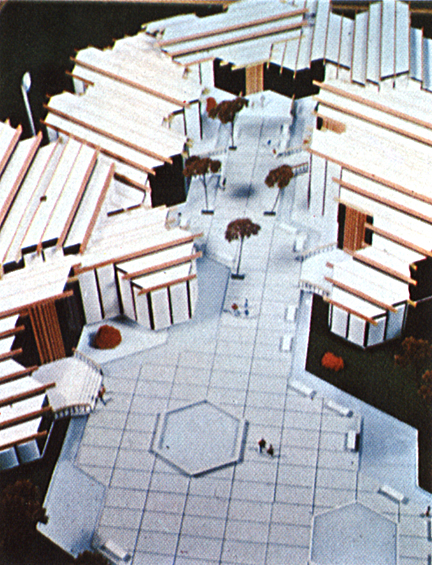 A notable element of the Quebec Industries pavilion was it's white roof and walls arranged in jagged steps and angles.
A notable element of the Quebec Industries pavilion was it's white roof and walls arranged in jagged steps and angles.Located in the Cité du Havre sector of Expo 67, the pavilion stood on the edge of the St. Lawrence river, right near Expo's main entrance. More than 100 Quebec industries participated in this exhibit, which was a supplement to the the province's official pavilion, and the only industrial pavilion presented by a Canadian province at Expo.
The theme of the Quebec Industries pavilion was The St. Lawrence Industrial Basin, illustrating the past and present of the river as a center of Quebec's economic activity. The province's economic potential was presented, and the pavilion boasted Quebec's superiority in such industries as asbestos mining and textile production.
 Hydro electric power was featured as one of the provinces most important industries. Every day from 9am to 10pm, visitors could watch the progress being made in the construction of Hydro-Quebec's Manicouagan dam. A 160 seat projection room showed live images on a 650 square-foot screen. In 1967, this was the longest closed circuit television system in the world; some 500 miles seperated subject and audience.
Hydro electric power was featured as one of the provinces most important industries. Every day from 9am to 10pm, visitors could watch the progress being made in the construction of Hydro-Quebec's Manicouagan dam. A 160 seat projection room showed live images on a 650 square-foot screen. In 1967, this was the longest closed circuit television system in the world; some 500 miles seperated subject and audience.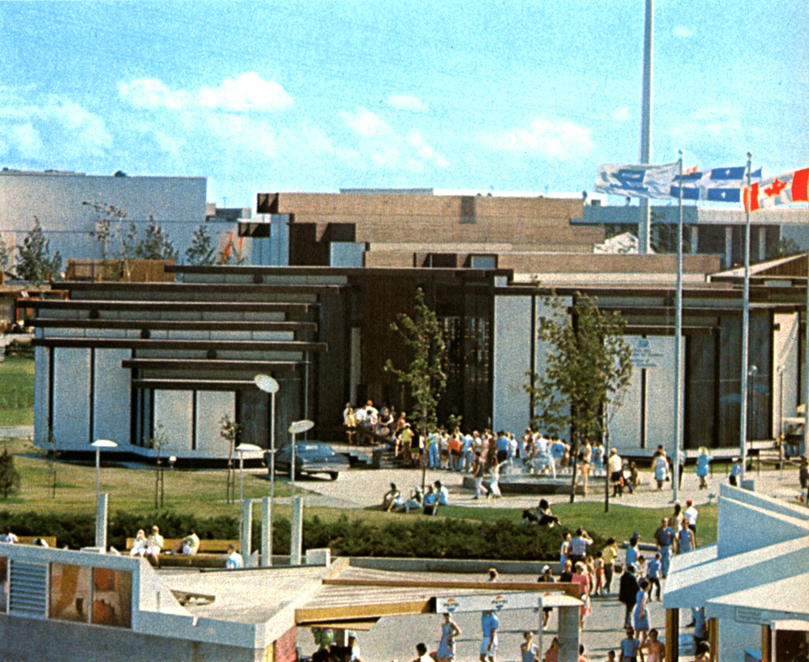 images: (top) ebay.com (2-3-4) personal collection
images: (top) ebay.com (2-3-4) personal collectionSaturday, November 25, 2006
Walt Disney's EPCOT Project
 In the early 1960's, entertainment mogul Walt Disney was blessed with a loving family that included many grandchildren. Walt became concerned with the world in which these kids would grow up: modern cities were chaotic, dirty and crime ridden.
In the early 1960's, entertainment mogul Walt Disney was blessed with a loving family that included many grandchildren. Walt became concerned with the world in which these kids would grow up: modern cities were chaotic, dirty and crime ridden.With the success of the Disneyland theme park in Anaheim, California, Walt began to dream of a far more ambitious project. What if the concepts of space and building design used in the Disneyland theme park could be used in the planning of communities, even entire cities? Walt began to devour books pertaining to urban planning, and anything else that could be usefull towards what he would later call his "prototype of the future"...
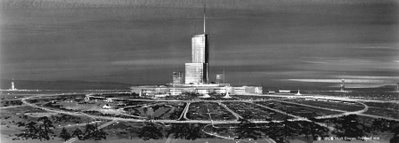 The Walt Disney company had purchased 27 400 acres of swampland near Orlando, Florida. Walt intended to use this land for his project, which was now being called the Experimental Prototype Community Of Tomorrow, or EPCOT for short.
The Walt Disney company had purchased 27 400 acres of swampland near Orlando, Florida. Walt intended to use this land for his project, which was now being called the Experimental Prototype Community Of Tomorrow, or EPCOT for short.The original EPCOT plans used the radial (pie shaped) concept. It was to have 20 000 permanent residents, a Jet Airport of the Future, schools, stores, offices and theatres. EPCOT was to be completely enclosed, sheltered from the outside elements.
 Cars and trucks would use underground passageways, while visitors and residents would rely on a monorail system to get around.
Cars and trucks would use underground passageways, while visitors and residents would rely on a monorail system to get around. An important element to Walt Disney's original plan was EPCOT's Industrial Park. Major American industries would use this facility to develop new technologies for use in the EPCOT city. Walt's idea was that visitors from across the world would be inspired by these new developments and want to implement them in their own countries.
An important element to Walt Disney's original plan was EPCOT's Industrial Park. Major American industries would use this facility to develop new technologies for use in the EPCOT city. Walt's idea was that visitors from across the world would be inspired by these new developments and want to implement them in their own countries. The following video is a 24-minute pitch reel from 1966, in which Walt describes the EPCOT project:
The following video is a 24-minute pitch reel from 1966, in which Walt describes the EPCOT project:images: waltopia.com
Friday, November 24, 2006
Expo 67 Souvenirs
 An event the size and scope of Expo 67 is sure to have it's share of trinkets and memorabilia for visitors to take home as souvenirs.
An event the size and scope of Expo 67 is sure to have it's share of trinkets and memorabilia for visitors to take home as souvenirs.The amount (and diversity) of items produced for Expo 67 was mind boggling: postcards, coloring books, slide photography, 8mm movie reels, stamps, keychains, coffee cups, dishes, serving trays, drinking glasses, beer steins, t-shirts, neckties, flight bags, shoes, sunglasses, match sticks, cigarette lighters, etc., etc...
This does not include the plethora of jewels, handicrafts and products that each participating country sold at their pavilions!
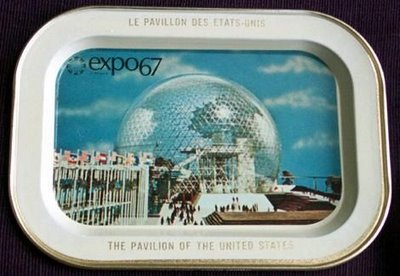

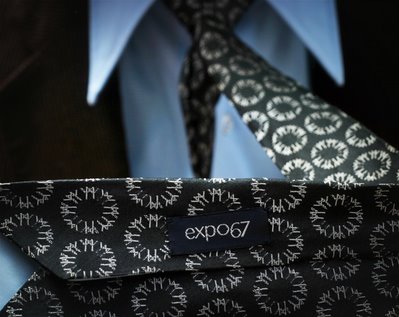
 images: (1 and 5) library and archives Canada
images: (1 and 5) library and archives Canada(2) expo67.ncf.ca
(3 and 4) Janicke Morissette (www.lebureauofficiel.com)/
Jean-François Brière (www.jfbriere.com)
Thursday, November 23, 2006
Monday, November 20, 2006
Marvin Gaye and Tammi Terrell
 By the mid-1960's, Mavin Gaye was one of Motown's top solo performers.
By the mid-1960's, Mavin Gaye was one of Motown's top solo performers.In 1964, Tammi Terrell was signed by Motown founder/producer Berry Gordy, originally as a solo artist. She had a few moderately successful hits, but it wasn't until 1967, upon her pairing-up with Marvin Gaye, that she shot to stardom. Their 1967 duet album "United" spawned such hits as "Ain't No Mountain High Enough" and "Your Precious Love".
Though Terrell and Gaye were both in seperate relationships, their artistic chemistry was unmistakeable. They convincingly portrayed lovers with their duets and Gaye even claimed that for the durations of their songs, he was in love with her.
The video presented here is from a special entitled "The Swinging Sounds of Expo 67". Marvin Gaye and Tammi Terrell perform "Ain't No Mountain High Enough" on the site of Expo 67.
photo: classic.motown.com
Friday, November 17, 2006
The Suntan
The modern suntan fad was launched when Coco Chanel accidentally obtained a dark tan while vacationing in the French Riviera in the 1920's. Up until that point, a suntan was a sign of lower class outdoor labour. As these labour patterns shifted in the early 20th century, a suntan became the symbol of wealth and leisure.
Coppertone was introduced in 1944 by Benjamin Green, as a lotion to darken tans. Hollywood stars (such as Sandra Dee) were used to advertise Coppertone products throughout the 1950's and into the 60's:
 By the 1960's, tanning was an artform. An entire generation baked itself in the sun using sun reflectors and baby oil.
By the 1960's, tanning was an artform. An entire generation baked itself in the sun using sun reflectors and baby oil.
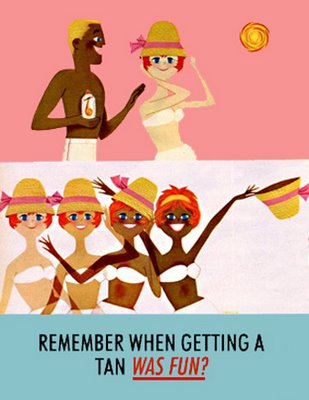 The 1970's saw advances in tanning products, such as this ad for Coppertone QT ("Quick Tan") lotion:
The 1970's saw advances in tanning products, such as this ad for Coppertone QT ("Quick Tan") lotion:
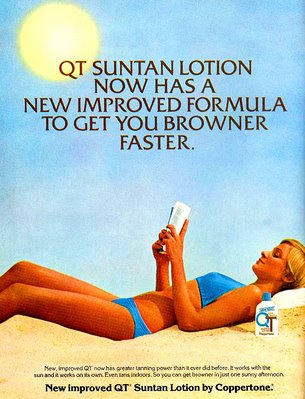 The suntan fad was at it's peak during the 1970's. No celebrity represented this look better than Farrah Fawcett. Ah, that tan. That smile. That hair!
The suntan fad was at it's peak during the 1970's. No celebrity represented this look better than Farrah Fawcett. Ah, that tan. That smile. That hair!
 Suntanning and the smell of suntan lotion have a deeply nostalgic hold on me. They conjure up happy memories of summers as a young child.
Suntanning and the smell of suntan lotion have a deeply nostalgic hold on me. They conjure up happy memories of summers as a young child.
images: (1) sandradeefans.com
(2) hipstercards.com
(3-4) source unknown
Coppertone was introduced in 1944 by Benjamin Green, as a lotion to darken tans. Hollywood stars (such as Sandra Dee) were used to advertise Coppertone products throughout the 1950's and into the 60's:
 By the 1960's, tanning was an artform. An entire generation baked itself in the sun using sun reflectors and baby oil.
By the 1960's, tanning was an artform. An entire generation baked itself in the sun using sun reflectors and baby oil. The 1970's saw advances in tanning products, such as this ad for Coppertone QT ("Quick Tan") lotion:
The 1970's saw advances in tanning products, such as this ad for Coppertone QT ("Quick Tan") lotion: The suntan fad was at it's peak during the 1970's. No celebrity represented this look better than Farrah Fawcett. Ah, that tan. That smile. That hair!
The suntan fad was at it's peak during the 1970's. No celebrity represented this look better than Farrah Fawcett. Ah, that tan. That smile. That hair! Suntanning and the smell of suntan lotion have a deeply nostalgic hold on me. They conjure up happy memories of summers as a young child.
Suntanning and the smell of suntan lotion have a deeply nostalgic hold on me. They conjure up happy memories of summers as a young child.images: (1) sandradeefans.com
(2) hipstercards.com
(3-4) source unknown
Monday, November 13, 2006
Revisit The German Pavilion!
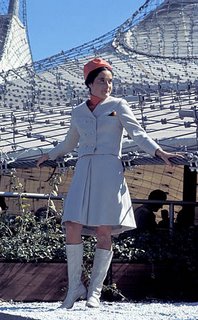 With over 10 million visitors, the Federal Republic of Germany pavilion was the third most visited at Expo 67 (after the USSR and Canada).
With over 10 million visitors, the Federal Republic of Germany pavilion was the third most visited at Expo 67 (after the USSR and Canada).Architect Rolf Gutbrod and structural engineer Frei Otto won critical acclaim for their gleaming white tent. It was completely portable, weighing one third to one fifth less than structures of comparable size... it covered an expanse of 100 000 feet!
Our charming German hostess (sporting fab go-go boots) invites us to take a second look at this spectacular pavilion situated at water's edge on Île Notre-Dame:
 Seperating walls were almost completely omitted in the exhibit area:
Seperating walls were almost completely omitted in the exhibit area: Natural light flowed in freely through the pavilion's translucent "skin":
Natural light flowed in freely through the pavilion's translucent "skin": The pavilion's patio restaurant was one of the most popular at Expo:
The pavilion's patio restaurant was one of the most popular at Expo: Germany's magnificent tent was particularily stunning lit up at night:
Germany's magnificent tent was particularily stunning lit up at night: images: (1-2-4-6) library and archives Canada
images: (1-2-4-6) library and archives Canada(3-5) FOS productions
Subscribe to:
Posts (Atom)


